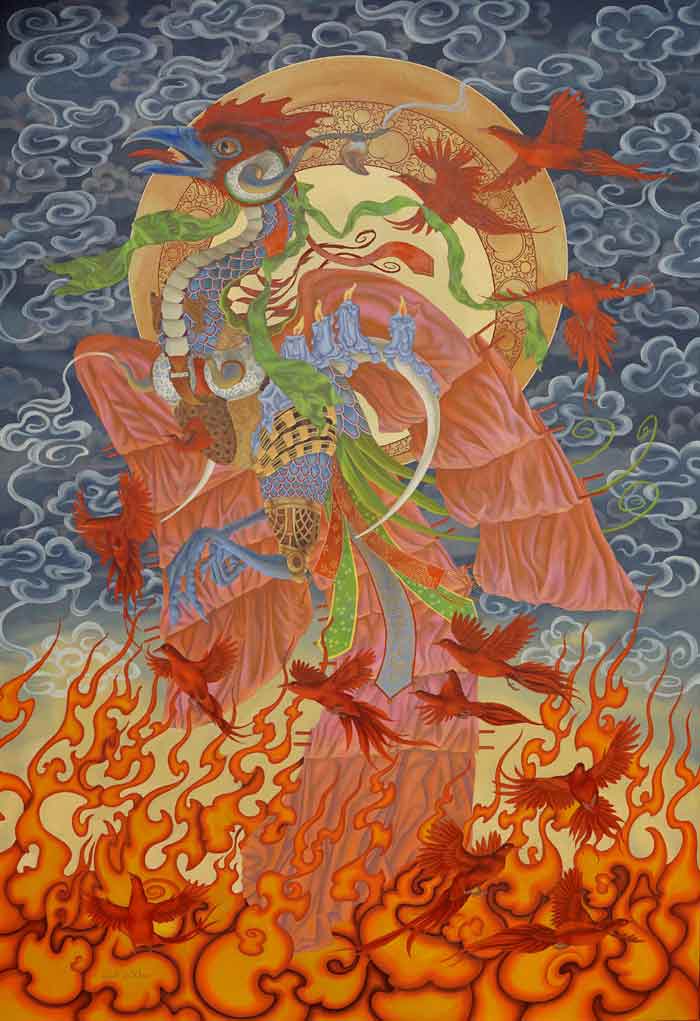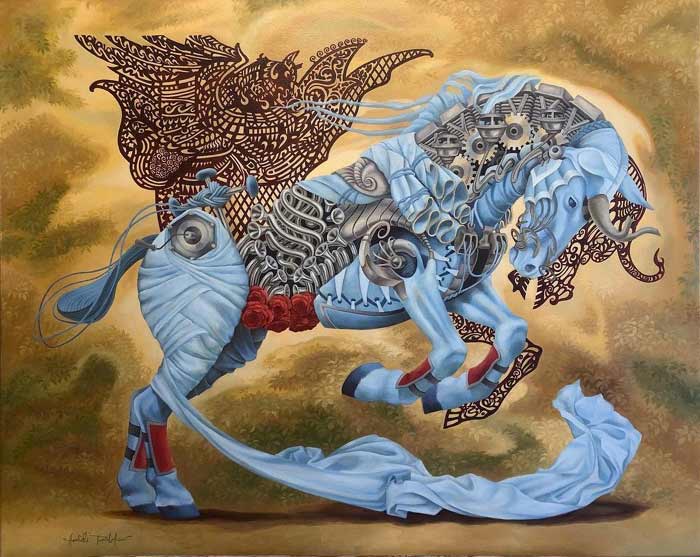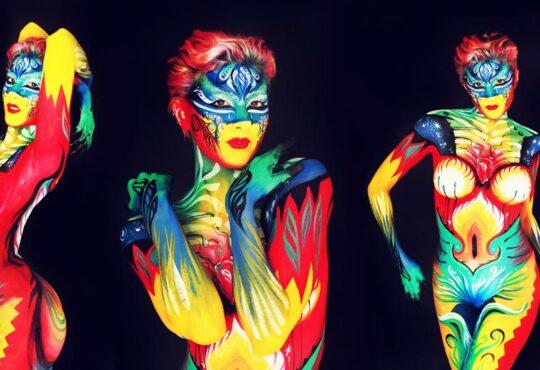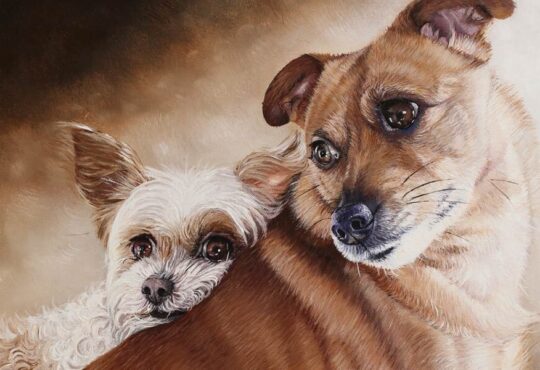Heidi Taillefer’s paintings inspired by various cultural beliefs and mythologies
The works included in this collection were all produced within the last ten years, from 2010 to 2020. During that time, my work had already begun to evolve from mere mechanistic depictions of people and animals, to include a deeper meaning which considered aspects of our human condition, set within the framework of our increasing merger with technology and AI.
Often these images were inspired by emotional turmoil, such as a breakup or conflict of some kind, as in the painting “Pelican and the Vampire” which in the end is a piece about unconditional love. Eventually, I began to explore the idea of balance and symmetry, as seen in “Mischief Maker”, depicting winged constructions that at times incorporate elements found in folk religions such as Santeria. This idea came to me through what I believe to have been an anomalous experience as a result of deep meditations, in which I could feel my “chakras” as “non-physical” physical sensations. Religion and spirituality have begun to take greater prominence in my work, noted especially in “Ein Sof”, “The Angel’s Share” and “Karma”, examining the idea of our merger with artificial intelligence, and what becomes of consciousness once these mechanical aids are set into place. Another source of inspiration is my own personal health or the health of society in general, and at times I paint looking forward as if to conjure an end result as a hopeful reminder of where we want to be. I find that painting during a pandemic is actually a challenging endeavor, so I dedicated the last two works of 2020 to our global struggle to regain control over our lives and depicted a universal symbol of rebirth and renewal, the mythical Phoenix.
As is usual for my work, most of the images in the series draw upon stories found in various cultural beliefs and mythologies throughout the world. Whether it be ancient Roman or Greek mythology, Hinduism, Buddhism, Santeria, or Kabbalah, I am often inspired by cultural stories and mythologies, and I try to make sense of life by incorporating these into my paintings which are also a puzzle to be figured out by the viewer. ~ Heidi Taillefer
The Angel’s Share

The Angle’s Share is the embodiment of Durga, symbolically represented as a tiger which is her traditional mount. She lies serenely on her side and offers prayers up into the heavens, which are symbolized by vapors released in the form of clouds, which also represent the distillation of consciousness. The title of Angels Share is taken from a phenomenon which exists in the brewing process whereby a significant portion of spirits gets lost to evaporation in the distillation process, as opposed to the Devil’s Cut, in which a portion of spirits is lost in the distillation process due to it’s absorption by the cask.
Equivalence of Form

“Equivalence of Form” is a principle found in Kabbalah whereby our ultimate goal in life is to achieve a likeness with our divine creator. Likeness equals proximity, and as each tiger emerges from the one above, it twists itself into a spiral leading back upward to it’s the ultimate source of creation and bliss. The image is a metaphor for God, which lunges overtop and is made up of the finest particulate, while humanity is represented by increasingly heavier and more massive elements below.
Karma

Karma depicts two opposing forces engaged in a karmic interplay, where the actions of each subject affects the outcome of the other. They are tethered together like puppets on a string and struggle to release themselves from their mutual influence in a circular cycle that continues indefinitely.
Ein Sof

“Ein Sof” is the Kabbalistic term for the great infinite expanse that existed before the ten emanations of God-consciousness were made manifest. These ten emanations are like dimensions of consciousness, such as wisdom, judgment, mercy, and love, through which the upper light passes until it finally reaches us below. The painting is a depiction of the Tree of Life in Kabbalah, a structure featuring these ten dimensions of consciousness, also known as Sephirot.
Dovetail

“Dovetail” is a painting about the mythical Phoenix. Incorporating elements found in China and Japan, the image is meant to convey the universality of this creature which is found all throughout Asia. It was my last painting of 2020 and was meant as another wish to regain some normalcy during this pandemic which has not yet reached its peak. As a symbol of renewal and rebirth, I was hoping to use a little Juju magic to conjure a desired wish for the world at large, and it sits as a kind of talisman to that end.
Resurrection

“Resurrection” is a painting whose title speaks for itself. It is an image of a mythical Phoenix, incorporating elements found in China and Japan to represent the universality of this subject. It was painted as a wish to conjure an end to this terrible pandemic. I am currently very optimistic and trying to focus on the solution to a massive problem which binds us all collectively, so these colorful birds are hopeful reminders that better times are ahead of us.
Kingfisher

“Kingfisher” is a depiction of our increasing merger with technology, and the horse represents the enormous power this conveys, in addition to the responsibility. It is a more traditional image which I would have produced earlier in my career, but it nonetheless represents the ubiquity of technology throughout society and our increasing merger with it.
Pelican and the Vampire
 The Pelican and the Vampire is a painting about unconditional love. The woman represents the pelican, which sailors used to think offered their chests and blood as food for their young when they came back empty billed from a foray out into the oceans. This was because of how the chicks appear to feed when pelicans feed their young, and in the middle ages, it became a Christian symbol of unconditional love. In the painting there are various religions which depict this quality and depth of love, the four blue arms represent the most powerful female deity in Hinduism named Kali (a much-misunderstood figure which I learned is the most powerful deity in Hinduism and represents that which is feared the most, but if you can appeal to her and approach her without fear, she will protect you), the arch has Islamic motifs, the shell represents Venus, the Roman goddess of love and beauty, and the sovereign’s orb in her hand represents Christianity. This is to span the breadth of nations across the world throughout the ages, and all belief systems but of course I couldn’t include them all. In my estimation, I have always perceived women of color as being the most unjustly maligned in the world, and I wanted to exalt them to the highest status in the face of such opposition. So the woman in the painting has finally tamed the demons of society which succumb to her charms and sit at her feet as she stands with grace, victorious and free from oppression or even resentment. It’s a very idealistic and utopian wish, and I know it might be too much to expect in light of the terrible insult women of color can suffer in society, but it was to pierce through prejudice and feature a long-overlooked feminine beauty, power and wisdom as victorious in the end.
The Pelican and the Vampire is a painting about unconditional love. The woman represents the pelican, which sailors used to think offered their chests and blood as food for their young when they came back empty billed from a foray out into the oceans. This was because of how the chicks appear to feed when pelicans feed their young, and in the middle ages, it became a Christian symbol of unconditional love. In the painting there are various religions which depict this quality and depth of love, the four blue arms represent the most powerful female deity in Hinduism named Kali (a much-misunderstood figure which I learned is the most powerful deity in Hinduism and represents that which is feared the most, but if you can appeal to her and approach her without fear, she will protect you), the arch has Islamic motifs, the shell represents Venus, the Roman goddess of love and beauty, and the sovereign’s orb in her hand represents Christianity. This is to span the breadth of nations across the world throughout the ages, and all belief systems but of course I couldn’t include them all. In my estimation, I have always perceived women of color as being the most unjustly maligned in the world, and I wanted to exalt them to the highest status in the face of such opposition. So the woman in the painting has finally tamed the demons of society which succumb to her charms and sit at her feet as she stands with grace, victorious and free from oppression or even resentment. It’s a very idealistic and utopian wish, and I know it might be too much to expect in light of the terrible insult women of color can suffer in society, but it was to pierce through prejudice and feature a long-overlooked feminine beauty, power and wisdom as victorious in the end.
Venus Envy
 “Venus Envy” is a depiction of the power and potency of womanhood, whether good, bad, ugly or sublime.
“Venus Envy” is a depiction of the power and potency of womanhood, whether good, bad, ugly or sublime.
Starting Something You Can’t Finish
 “Starting Something You Can’t Finish” is the first of a series of symmetrical paintings I produced, inspired by an anomalous experience I had during deep meditations where I was able to feel my chakras as “non-physical” physical sensations. The heart chakra is particularly sensitive and became debilitatingly painful as its aperture felt as if it were being stretched open beyond its limits at all times, with no solution as to how to stop this constant sensation.
“Starting Something You Can’t Finish” is the first of a series of symmetrical paintings I produced, inspired by an anomalous experience I had during deep meditations where I was able to feel my chakras as “non-physical” physical sensations. The heart chakra is particularly sensitive and became debilitatingly painful as its aperture felt as if it were being stretched open beyond its limits at all times, with no solution as to how to stop this constant sensation.
Mischief Maker
 Mischief Maker is part of a series I began on symmetry, featuring one of the many orisha’s found in Santeria, a Cuban folk religion brought over by African slaves and merged with Catholicism. An orisha is a spirit which offers protection or qualities to those who invoke it’s powers, as found in various syncretic religions throughout the world, such as Santeria, Voodoo, or Candomblé, to name a few. In this case I depicted Ibeji, which is a single orisha manifested as a set of twins who offer up joy, happiness, abundance, and mischief making. The twins are called Taewo (male, red) and Kehinde (female, blue) and are represented in the painting by a rooster and chicken head.
Mischief Maker is part of a series I began on symmetry, featuring one of the many orisha’s found in Santeria, a Cuban folk religion brought over by African slaves and merged with Catholicism. An orisha is a spirit which offers protection or qualities to those who invoke it’s powers, as found in various syncretic religions throughout the world, such as Santeria, Voodoo, or Candomblé, to name a few. In this case I depicted Ibeji, which is a single orisha manifested as a set of twins who offer up joy, happiness, abundance, and mischief making. The twins are called Taewo (male, red) and Kehinde (female, blue) and are represented in the painting by a rooster and chicken head.








